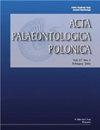New materials of multicellular algae from the earliest Cambrian Kuanchuanpu biota in South China
IF 1.9
3区 地球科学
Q2 PALEONTOLOGY
引用次数: 0
Abstract
The Kuanchuanpu biota (ca. 535 Ma) from the basal Cambrian in South China yields various phosphatized, three-dimensionally preserved microscopic fossils, such as animal embryos, cyanobacteria, and algae. This provides an exceptional window for investigating the rapid divergent evolution of animal phyla in the early Cambrian ocean. However, the fossil eukaryotic algae are poorly documented and are not properly incorporated into the conceptual food web of the Cambrian ocean ecosystem. In this study, we report a new taxon of calathiform alga, Calathophycus irregulatus Tang gen. et sp. nov., and an indeterminate alga, from the Kuanchuanpu biota. Calathophycus irregulatus can be distinguished from other reported phosphatized multicellular algal fossils from the Kuanchuanpu biota and the Ediacaran Weng’an biota (Guizhou Province, China), based on the external morphology and features of cell clump aggregation. The observation of C. irregulatus and the indeterminate alga indicates a certain diversity of algae at the beginning of the Cambrian. Concerning the regularly or irregularly shaped multicellular algal fossils from the Kuanchuanpu Formation, co-occurring spherical fossils, previously interpreted as “cleavage stage” of animal embryos, should be reconsidered in affinity.华南最早寒武纪宽川堡生物群多细胞藻类新材料
华南底寒武纪宽川铺生物群(约535 Ma)发现了各种磷化的、三维保存的微观化石,如动物胚胎、蓝藻和藻类。这为研究早寒武纪海洋动物门的快速分化进化提供了一个特殊的窗口。然而,真核藻类化石文献很少,并没有被适当地纳入寒武纪海洋生态系统的概念食物网。本文报道了宽川铺生物群中一种新的Calathophycus irregulatus Tang gen. et sp. nov.和一种不确定的藻类。Calathophycus irregulatus可以根据细胞团聚集的外部形态和特征与其他已报道的来自贵州宽川堡生物群和埃迪卡拉系翁安生物群的磷化多细胞藻类化石区分开来。C. irregulatus和不确定藻的观察表明,寒武纪初期藻类具有一定的多样性。对于宽川铺组不规则或不规则形状的多细胞藻化石,应重新考虑先前被解释为动物胚胎“卵裂期”的共生球形化石的亲和性。
本文章由计算机程序翻译,如有差异,请以英文原文为准。
求助全文
约1分钟内获得全文
求助全文
来源期刊

Acta Palaeontologica Polonica
地学-古生物学
CiteScore
2.80
自引率
5.60%
发文量
36
审稿时长
12.5 months
期刊介绍:
Acta Palaeontologica Polonica is an international quarterly journal publishing papers of general interest from all areas of paleontology. Since its founding by Roman Kozłowski in 1956, various currents of modern paleontology have been represented in the contents of the journal, especially those rooted in biologically oriented paleontology, an area he helped establish.
In-depth studies of all kinds of fossils, of the mode of life of ancient organisms and structure of their skeletons are welcome, as those offering stratigraphically ordered evidence of evolution. Work on vertebrates and applications of fossil evidence to developmental studies, both ontogeny and astogeny of clonal organisms, have a long tradition in our journal. Evolution of the biosphere and its ecosystems, as inferred from geochemical evidence, has also been the focus of studies published in the journal.
 求助内容:
求助内容: 应助结果提醒方式:
应助结果提醒方式:


